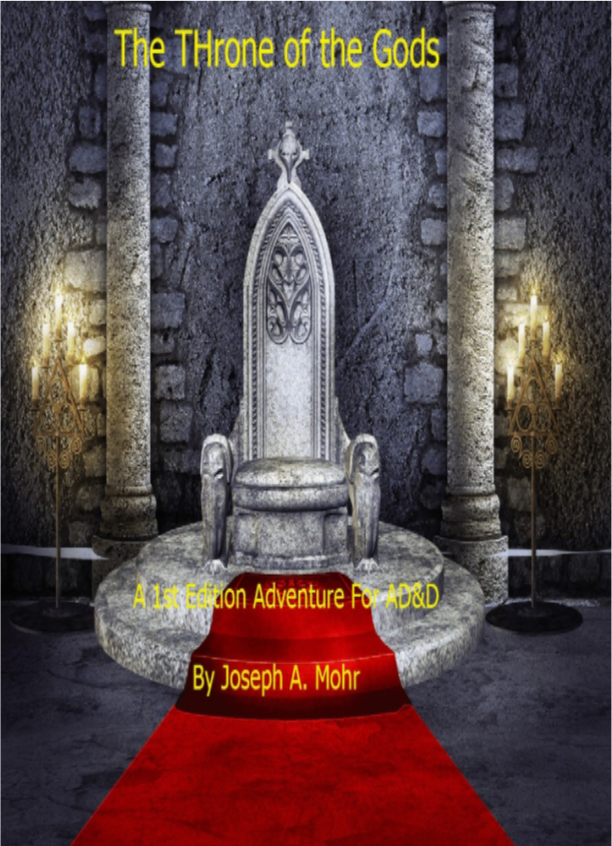
By Joseph Mohr 1e Levels 15+
Rumors have reached the adventurers about the recent discovery of the legendary Throne of the Gods. This epic level journey will take the adventurers to places of unimaginable danger. But the adventurers may not be the only ones seeking this artifact.
This 34 page adventure describes a two level dungeon with about thirty rooms that has the Throne of the Gods at the End. Or, as the cover states: “The THrone of the Gods.” It is basically just a series of fights. Monster Zoo, with padded writing.
What is a D&D adventure? A series of challenges to overcome? But if that model is adhered to too strictly, ot literally, you can get a flat adventure. Just a series of rooms with monsters in them. Or a series of puzzle traps. Or a series of riddles. Or … Whatever. It’s hard to argue that those elements are not a part of D&D adventures but when the D&D adventure starts from that framework I think you get substandard work.
And that’s the case with this adventure. It doesn’t feel like a real place. It doesn’t feel like it started out as caves, or a throne room, or whatever. It feels like it started out as a series of challenges to be overcome. Room after room of high HD monsters. Roc’s. Mind Flayers. Beholders. Dragon Turtle. Devils. Titan. NPC Parties. It’s a monster zoo of high HD enemies.
The designer does say that high level adventures are hard, and I would agree. I’m not sure anyone has cracked that nut. It’s certainly one of the largest unsolved issues in D&D. A dungeon full of monsters to hack doesn’t do it.
To it’s credit it doesn’t gimp the party. But it’s really just room after room of monsters to cut down with a couple of dead-ends or a puzzle/evil alter or two. It feels more like a 4e adventure with its focus on combat.
And then there’s Maude. Err, the text. ¾ of a column to describe a dead body. Padding the text with phrases like “Should anyone climb up the statue and inspect the mouth of it they may find a …” or “Should you use divine magic then you learn [something irrelevent.]” Or telling us, at a certain pit, that a Monk may be able to reduce their falling damage through the use of one of their powers. Well, yes. Why tell us that? Do you also explain how to use Thac0 in every combat, noting it was optional in 1e? Or how MU’s cast spells?
This is available, freely, at Dragonsfoot.

I recently picked up Anthony Huso’s Mortuary Temple of Esma and Fabled City of Brass. As far as deadly AD&D adventures go, they’re pretty well done. Or at least, for as mechanical as 1e is, they’re still heavy on the same eldritch vibe of some of the best late-70s/early-80s modules (D3, WG4, Dark Tower, etc.). Unlike what this adventure sounds like, they feel like real places.
By coincidence I’m going through Against the Slave Lords as a player, and holy crap is it a railroad. One poor guy is mapping the dungeons, but the jacquay map would be a single straight line, with a bunch of tough monster fights on it.
And this is supposed to be one of the classics. (Though maybe it was just a touchstone, a bad adventure that a lot of people played.) Dragonsfoot bills itself as “the home of 1st edition AD&D,” so in one sense “series of challenges” is just carrying on the finest traditions of their ancestors.
I’d still like to think there’s overlap between the OSR and plain old grognard Old School, but at the very least the center of gravity is different.
I think you have to remember the origin of the Slaver A series: they were tournament gauntlets, so by design railroads. (There are amusing stories of players interrogating captives about how they got into the room, given the deadly traps.) Modules were built around these. When you get to the surface in A4 In the Dungeons of the Slave Lords your objective is to get safely off the island, and there are multiple routes/means to do so. If you want to regain your equipment and get rich, then you need to defeat the remaining Slave Lords. The A series are far from typical “grognard Old School”; Gygaxian classics tend to be sandboxes with multiple routes available, and for the PCs to interact with as they see fit.
A4 blew our minds when we played it at the time- the bizarro Myconid community, the ant-bridge, the terror of having all your gear stripped away. All that was fresh and original to us- from memory the tunnels down there seemed a maze rather than a railroad and the chaos on the surface meant you could go any number of ways. We fought the SL… we perished.
Yes, the underground phase of A4 is indeed a system of tunnels and caves (with multiple exits possible). I like it, and it is certainly my favourite of the Slaver series. A1 to A3 have the railroad sections that made up the preliminary rounds of the tournament. They do contain some imaginative and exciting encounters.
Bryce, I just donated to your cause. The amount of entertainment I’ve received from this site rivals any I’ve ever enjoyed. Please keep the snark and education coming!